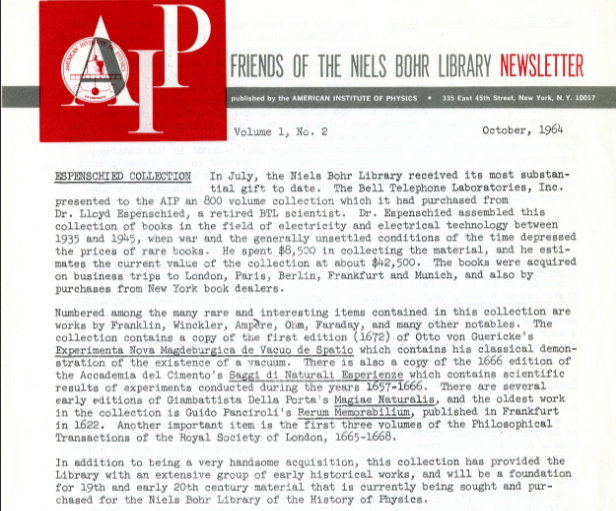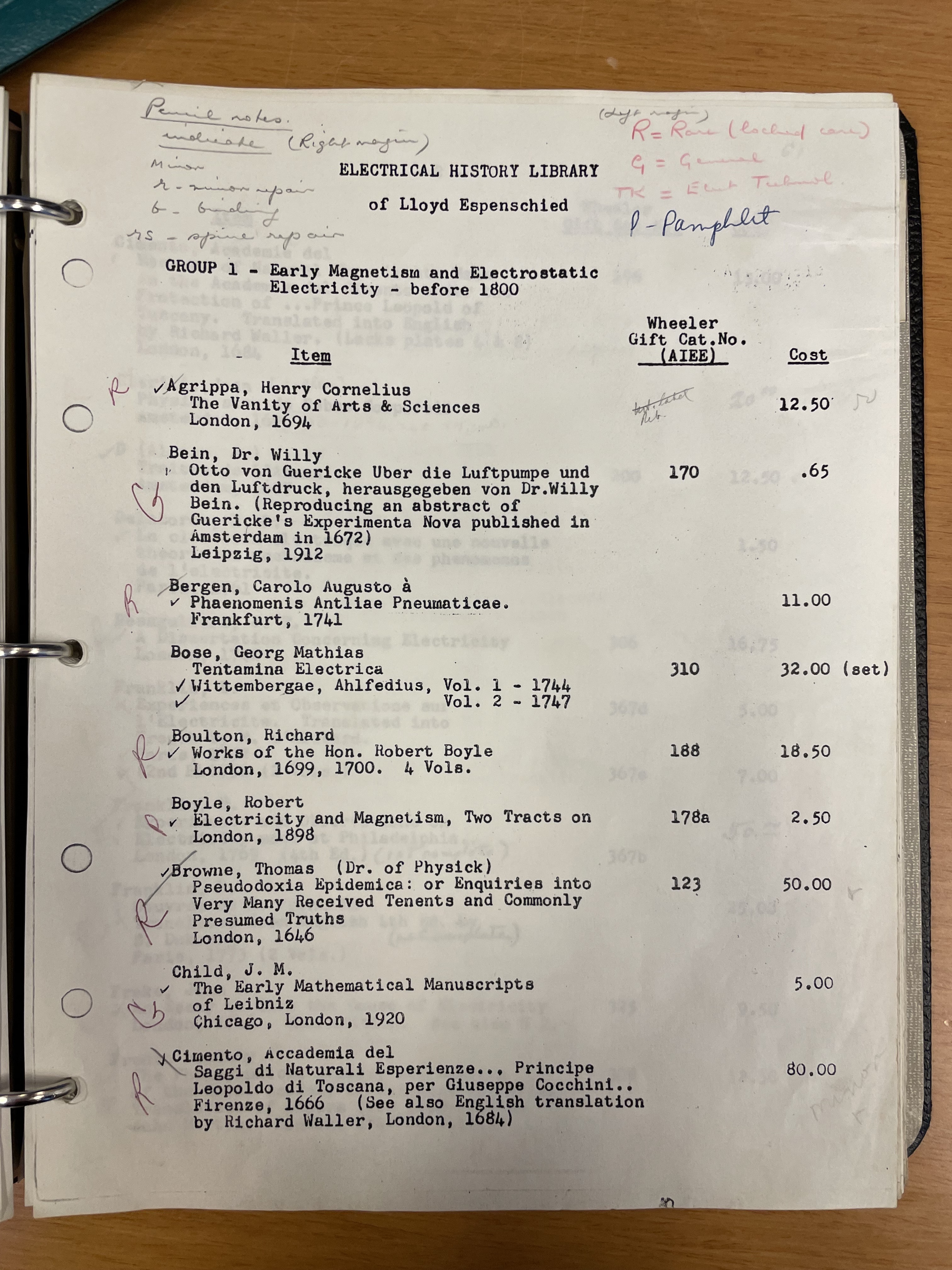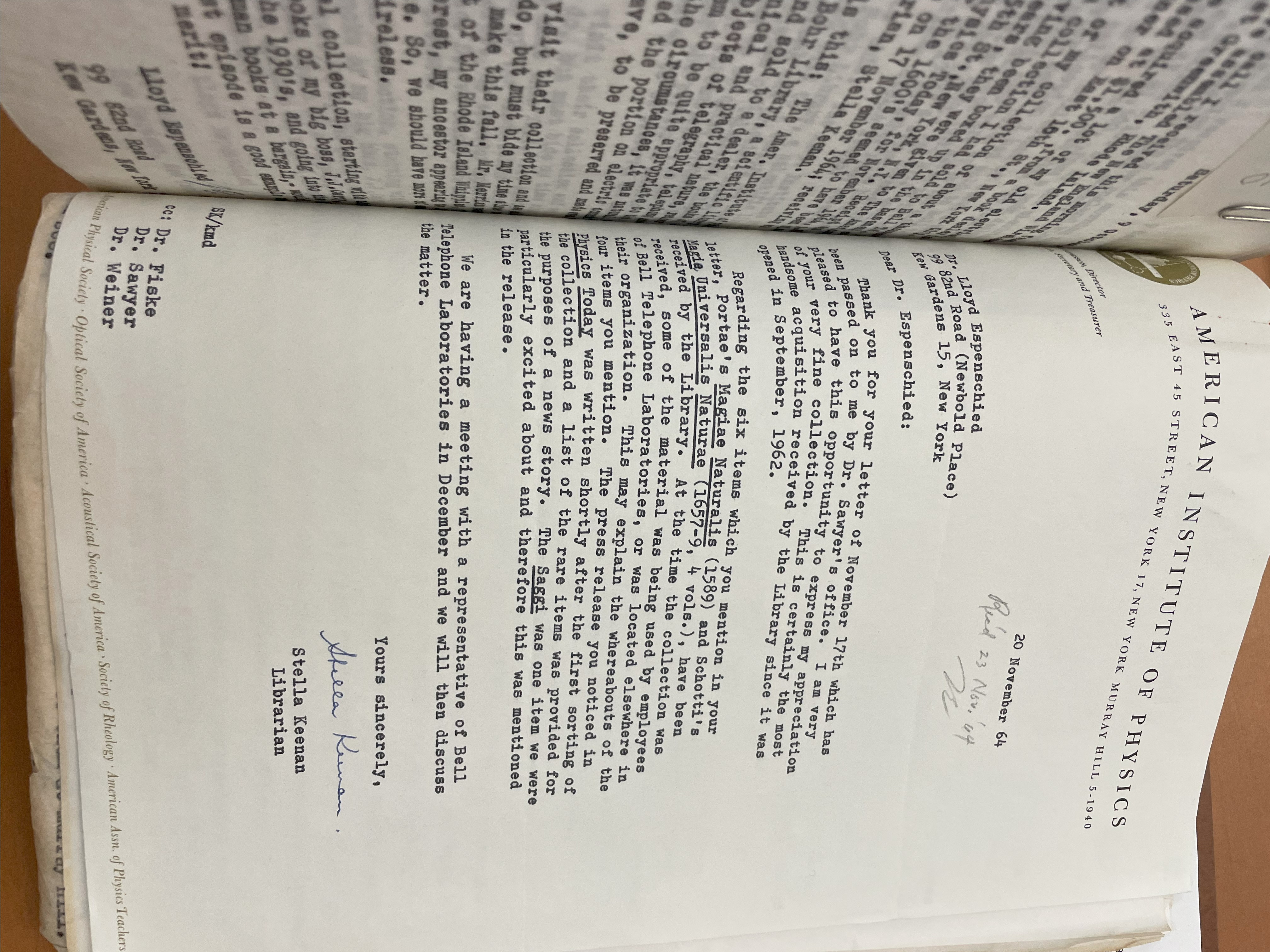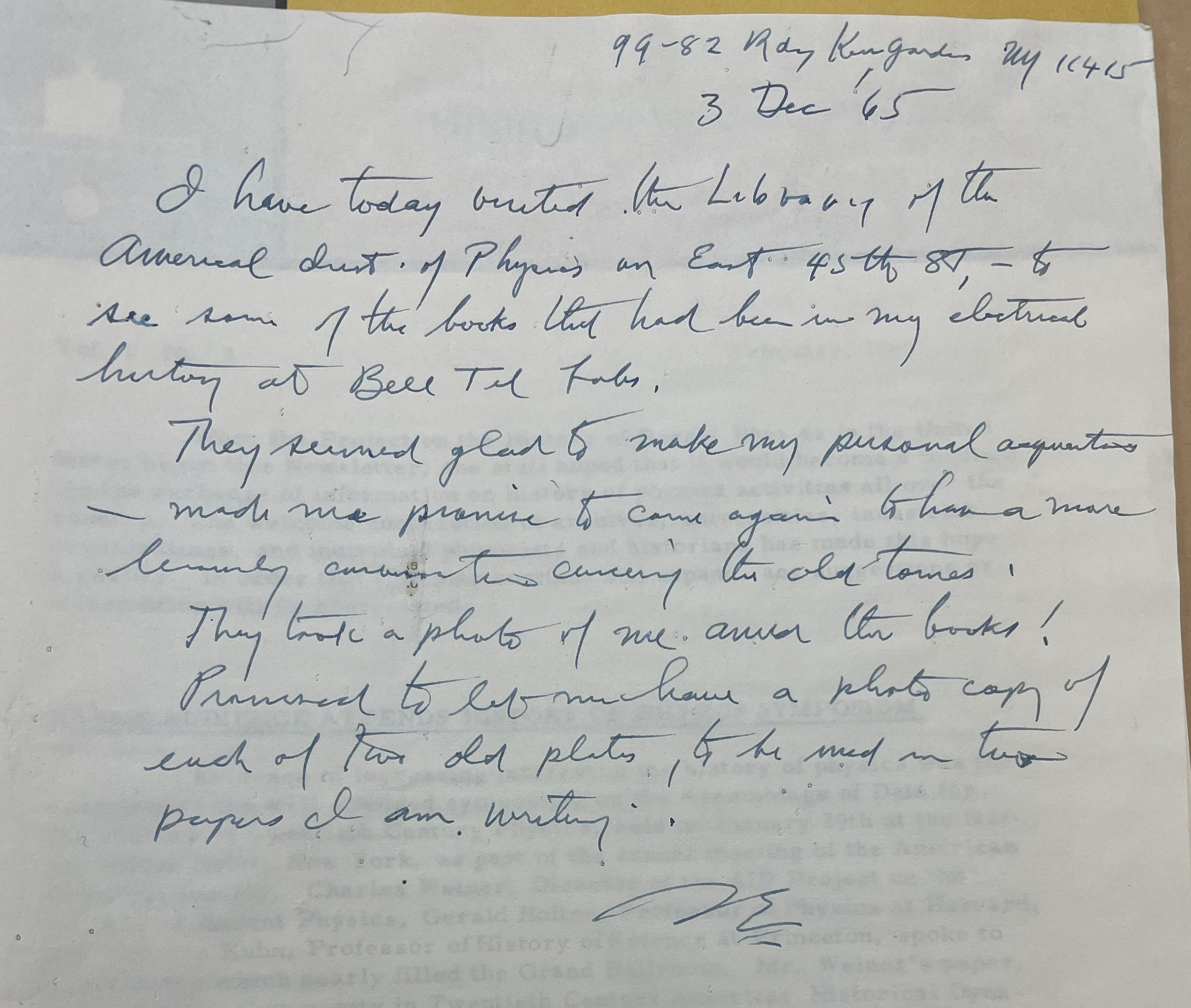Lloyd Espenschied’s Library of Electrical History
Over the past few months, we here at the Niels Bohr Library & Archives have been migrating to our new digital repository
Several of the books now available online come from the Espenschied Collection
Origins
The vast majority of books at the Niels Bohr Library & Archives come to us via donations from the personal libraries of scientists and historians. These donations often provide a fascinating glimpse into the lives of their previous owners, from the titles that showcase research interests to the annotations and ephemera that bear evidence of use and readership. Our online catalog
Traditionally, donations were marked by special bookplates and are now noted in our catalog records in the “Source of Acquisition” field. One aspect of our new digital repository is the ability to highlight some of those collections that tell a larger story beyond the bookplates and acquisition notes, ones where the books not only were part of someone’s life but were carefully curated to tell another story as well. Examples of collections that have been previously featured on our blog are the Forman Collection
While uploading the most recent batch of books to the repository, another collection’s story emerged, one that dates back to the earliest days of our library and was largely forgotten. In over 20 books, I found a book plate that reads: “In honor of Lloyd Espenschied, presented by Bell Telephone Laboratories, Inc.”

Bookplate for the Espenschied Collection
Niels Bohr Library & Archives
Who was Lloyd Espenschied? Why was it that Bell Telephone Laboratories gave us this collection, rather than him? How did Bell Labs end up with so many rare books?
Curious to find out more about this collection and answer these questions, I soon embarked on an unexpected and fascinating journey that led me to the Smithsonian Archives and our own records from the earliest days of NBLA, preserved by its first librarian, Stella Keenan.
The Hunt Begins
The first mention of the Espenschied Collection I was able to find was in the October 1964 issue of our library’s newsletter, which described the donation to AIP’s Niels Bohr Library (as it was then known) as originally consisting of over 800 rare books and the library’s “most substantial gift to date.” At the time, the library only had about 2,000 volumes, so this increased the collection by nearly 50 percent, and built a “foundation” for future rare book collections. For context, the library now holds over 30,000 volumes and about 2,000 rare books. The newsletter explains that the collection was originally the private library of a former Bell Labs scientist — Lloyd Espenschied — who sold it to the Bell Telephone Laboratories upon his retirement in the 1950s. Of note was that many of these works were bought during World War II when rare book prices, especially German texts, were extremely low.

Espenschied Collection announcement in the October 1964

Lloyd Espenschied
Given the significance and size of the collection mentioned in the newsletter (800 books!), I was shocked by how few records in our catalog appeared to have a donation note from this collection (less than 80), even among those which were digitized and clearly had the bookplate. Since these books were cataloged long before our online catalog existed and our practice of noting provenance in the catalog records, it made me wonder which books in our collection might have this bookplate that we are simply not aware of.
Without an inventory of this donation, it would be impossible to know which books to check for the bookplate, so my journey almost hit a dead end. However, I discovered that Lloyd Espenschied’s personal papers

Boxes from the Espenschied Papers at the Smithsonian Archives Center.
In those boxes, I not only found a complete inventory of Espenschied’s collection, which included the prices he paid for the books during the war in addition to the titles and authors, I also found copies of correspondence that revealed the story of how the collection came to be at AIP. Soon after my trip to the Smithsonian, I discovered additional correspondence in the library’s own archives relating to the Espenschied collection. Together, these letters revealed a more dramatic story than the newsletter described. Yes, the collection was originally collected by Espenschied, and then later given to us by Bell Labs, but the letters revealed that Espenschied was much more involved in their donation to AIP’s Niels Bohr Library than previously thought.
The Story of How the Espenschied Collection Came to AIP
In 1953, Lloyd Espenschied, nearing retirement from Bell Telephone Laboratories, began to seek a home for his “Library of Electrical Origins.” The Espenschied papers at the Smithsonian include a flyer he sent out to his friends in which he describes his collection thus:
They are source books, through which has come our electrical knowledge, written generally by the originators themselves. They run in date from about the year 1600 to the present time. They therefore constitute much of the basic literature, on magnetism, on vacuum technique, on electrostatic electricity, on the fundamentals of electromagnetism from which came the first industrialization, and on the beginnings of electronics and high frequency technology. In its applicational side the collection is directed largely at electric communications, radio and electronics. Tracing as it does the path of electrical knowledge down through the years, the value of this collection resides considerably in its ensemble. Hence it should be kept intact rather than dispersed. It could be merged with other foundational literature to give a more complete portrayal of the genesis of our electrical age 1
Espenschied built this collection of nearly a thousand books over many years, starting with the collection given to him from John J. Carty, his boss at AT&T, in the 1930s. It grew especially during World War II, while he was in Europe and prices for rare books, particularly German ones, were quite low. The collection also included books inherited from other scientists such as Professor Alfred Still and William Weaver.2
Fearing the collection would be broken apart and lose the irreplaceable context of the collection as a whole, Espenschied sought an institution that would preserve and make his collection accessible for future researchers. Bell Labs eventually stepped up, which was where the books were already located, and purchased the collection so that he could be compensated for his investment in the collection and live out his retirement. The plan was that these books would be made part of the Bell Telephone Laboratories’ library as historical reference books for scientists and outside scholars.3
Espenschied’s peace of mind did not last long, however. In 1958, four and a half years after leaving his collection with Bell Labs, he tried to visit his collection and was dismayed to find that the library staff had never heard of it. He soon discovered that “the collection is still boxed up in storage at West St. for lack of completion of indexing.”4 He then wrote to the president of Bell Labs, Mervin J. Kelly

Aerial view of Bell Telephone Laboratories in Murray Hill, New Jersey where the Espenschied collection was boxed up in the basement for years. Bell Labs H2
Credit Line: Bell Laboratories / Alcatel-Lucent USA Inc., courtesy AIP Emilio Segrè Visual Archives, Physics Today Collection
In April 1963, Espenschied wrote a letter entitled “B.T.L. Neglect” to the new president of Bell Labs, James Fisk
A few weeks later, Espenschied had lunch with fellow electrical historian and director of the newly formed history programs at AIP, W. James King, who expressed interest in Espenschied’s collection for the Niels Bohr Library. Espenschied, excited by the prospect of finding an appreciative home for his collection, but powerless to transfer the collection himself since he had sold it to Bell Labs and no longer had sway with the administration, wrote to King, “since you think the American Institute of Physics would appreciate these rare tomes, foundation-stones that they are to the electrical age, I suggest you expedite the making of a bid for them.”7
Espenschied sent King a copy of the inventory and his correspondence with Bell Labs, and King began the process of advocating to AIP why they should get Bell Labs to give them the collection.
A series of AIP internal memos were preserved in the AIP library archives by librarian Stella Keenan, which show the behind-the-scenes discussions about the acquisition of the collection that Espenschied was never privy to.
When the Niels Bohr Library & Archives was established in 1962 (then called the Niels Bohr Library), its initial collecting aim was works on the history of physics from the 18th-20th centuries. From the beginning there was also an interest in obtaining copies of important historical scientific works in the history of science, sourced largely from gifts and by seeking donations of books. By July 1964, the library contained 2,000 volumes and was looking to grow, although it was limited by budget (see Friends of the Niels Bohr Library Newsletter Vol. 1 No, 1, July 1964
W. James King immediately wrote to the then-AIP Director, Elmer Hutchisson
At this point there is a gap in correspondence until July 1964. During this time AIP successfully convinced Bell Labs to donate the collection to AIP and the boxes arrived on July 27th at the Niels Bohr Library at AIP’s New York headquarters.
At this time, with an influx of books poised to greatly expand and shift the focus of the collection, W. James King, began a discussion to consider how this would affect the future of the Niels Bohr Library’s collecting aims:
The Niels Bohr Library has now reached the stage in its development when it will be appropriate to consider its detailed organization in terms of its original goals. One of the chief questions to be considered is that the development of areas other than those of treatises in physics....such as the institutionalization of science, science education, science and government, science and the humanities, and science and technology. The question has been pointed up by the recent addition to the Library of the collection of Lloyd Espenschied. The collection is practically entirely made up of early treatises on electricity and magnetism, and of early works on electrical communications. This addition gives us an excellent nucleus for research as well as giving us a collection in a special field of physics, that of electricity and magnetism.10
This shift to consider growth in areas outside of technical monographs corresponded with the creation of our custom call number system, developed by Stella Keenan that year (and is still in use today
AIP was excited for the potential for the collection, and AIP Director Elmer Hutchisson writes to Bell Labs that “the Espenschied collection sets for us a standard of what we may be able to do in other branches of physics and will, I am sure, set as a powerful stimulant in erecting an even greater interest in this humanistic side of physics.”11
Over the next month, Stella Keenan, worked from a copy of Espenschied’s inventory to make our own inventory of the collection received from Bell Labs, taking meticulous notes and compiling a list of missing items which is preserved in our library files. She discovered that in the nine years the collection had been languishing in the the Bell Labs basement, over 300 titles had gone missing, including some of the rarest volumes. After an inquiry to Bell Labs, they found some of the materials, but most remained missing presumably due to use by employees over the years. They set up a meeting for December 1964 with Bell Labs to discuss the matter, since the selling of duplicates was unable to generate enough money to replace the missing volumes. (For example, Gaspar Schott’s Technica Curiosa

First page of AIP’s copy of the Espenschied Collection inventory. Photocopy of typed inventory sent by Lloyd Espenschied with annotations on top by AIP Librarian Stella Keenan.
Niels Bohr Library & Archives

In August 1964, AIP released its first press release about the collection, followed up by an announcement
After seeing the Physics Today article, Espenschied wrote to AIP leadership, happy to see his collection finally in its new home, but worried because the book stated as the oldest in the collection in the article, was not the oldest one originally there. To assuage Espenschied’s worry, Stella Keenan wrote back letting him know that the news article was from a preliminary inventory and older books had been found but also acknowledged that some of these books never made it to AIP.12

Letter to Espenschied from Stella Keenan letting him know about the missing books.
“Electrical history library of Lloyd Espenschied” Box 11, Lloyd Espenschied Papers, Smithsonian Archives Center, National Museum of American History

In December 1964, AIP’s Librarian Stella Keenan and History Project Director, Charles Weiner (who took over from W. James King in August) met with J. D. Tebo, Head of the Technical Relations Department at Bell Labs, to discuss the status and remaining issues with the Espenschied Collection donation. Afterwards Tebo followed up with W. K. Lowry, the librarian at Bell Labs, to inquire about the missing volumes, only to get confirmation that the volumes had been missing since before the move to Murray Hill in 1960.13
Thus with the inventory complete, missing book investigations reaching a dead end, and duplicates and out of scope material sold, the Espenschied Collection was finally cataloged and became part of the Niels Bohr Library.
A year later, in December 1965, Lloyd Espenschied was invited to the Niels Bohr Library to view his books. A lovely note in the Smithsonian Archives shows his delight at being asked to pose for photographs with his books and they joy of finally seeing the books in their forever home.

Note by Lloyd Espenschied recounting his visit to the Niels Bohr Library on December 3, 1965.
“History of Science American Institute of Physics” Box 14, Lloyd Espenschied Papers, Smithsonian Archives Center, National Museum of American History.

The Espenschied Collection Today
When identifying candidates for books to be digitized 10 years ago, over half of the volumes selected were from the Espenschied collection, which are now available online. In these books we find the history of the telegraph, the discovery of electricity, and maps of telegraph lines and geomagnetic poles — and that is only scratching the surface. Together with the other books in print, they tell the story of the history of physics through contemporary sources and discussions. You can explore the newly digitized Espenschied materials online in our new Espenschied Collection on the digital repository: https://repository.aip.org/espenschied-collection
Although their catalog records may have been separated from their original context, the books from the Espenschied Collection have remained some of our most important, beautiful, and unique volumes in our rare books collection.

Curus mathematicus: Mathematical Sciences in nine books
While it will take a while before all the other Espenschied materials are all reidentified in the catalog, researchers interested in studying his collection can still do so using the inventory that is on hand in our library files.
For more on Lloyd Espenschied, check out his oral history with the IEEE History Center from 1973
References:
- “A Library of Electrical Origins in Need of a Home”. Lloyd Espenschied. November 23, 1953. Lloyd Espenschied Papers, Smithsonian Archives Center, National Museum of American History (NMAH)
- ibid. and “Note on telephone call”, Lloyd Espenschied. 9 October,1965. Lloyd Espenschied Papers, Smithsonian Archives Center, NMAH.
- “Re: My Old Electrical History Library”, Lloyd Espenschied. 28 July 1960. Lloyd Espenschied Papers, Smithsonian Archives Center, NMAH
- Letter to M.J. Kelly, President of Bell Labs, from Lloyd Espenschied. 3 November 1958. Espenschied Collection Files (uncatalogued). Niels Bohr Library & Archives, American Institute of Physics.
- “Re: My Old Electrical History Library” Lloyd Espenschied. 28 July 1960. Lloyd Espenschied Papers, Smithsonian Archives Center, NMAH.
- “B.T.L. Neglect” Letter to Dr. James Fisk, president of Bell Labs, from Lloyd Espenschied. 26 April 1963. Espenschied Collection Files (uncatalogued). Niels Bohr Library & Archives, American Institute of Physics.
- Letter to W. James King from Lloyd Espenschied. 10 May 1963. Lloyd Espenschied Papers, Smithsonian Archives Center, NMAH
- “Dr. Lloyd Espenschied’s collection of books”. AIP Memo to Elmer Hutchisson from W. James King. 10 May 1963. Espenschied Collection Files (uncatalogued) Niels Bohr Library & Archives, American Insitute of Physics
- “Dr. Lloyd Espenschied’s collection of books”.AIP Memo to Elmer Hutchisson from W. James King. 14 May 1963. Espenschied Collection Files (uncatalogued). Niels Bohr Library & Archives, American Institute of Physics
- ”Niels Bohr Library” AIP Memo to Stella Keenan from W. J. King, cc: E. Hutchisson, W.G. Kelly, Gerald Holton, C. Wiener, J. Tebo. 27 July 1964. Espenschied Collection Files (uncatalogued), Niels Bohr Library & Archives, American Institute of Physics.
- Letter to Dr. W. O. Baker, Vice President of Research, Bell Telephone Laboratories from Elmer Hutchisson. 13 August 1964, Espenschied Collection Files (uncatalogued). Niels Bohr Library & Archives, American Institute of Physics.
- Letter to Lloyd Espenschied from Stella Keenan. 20 November 1964. Lloyd Espenschied Papers, Smithsonian Archives Center, NAMH.
- ”The Collection of Books Donated to the Niels Bohr Library” Letter from J. D. Tebo to Mr. W. K. Lowry, 7 December 1964 and Letter to Stella Keenan from J. D.Tebo 11 January 1965. Espenschied Collection Files (uncatalogued), Niels Bohr Library & Archives, American Institute of Physics.










